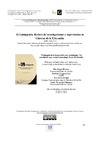Identificador persistente para citar o vincular este elemento:
https://accedacris.ulpgc.es/jspui/handle/10553/70291
| Campo DC | Valor | idioma |
|---|---|---|
| dc.contributor.author | López Meneses, Eloy | en_US |
| dc.contributor.author | Vázquez-Cano, Esteban | en_US |
| dc.contributor.author | Fernández Márquez, Esther | en_US |
| dc.date.accessioned | 2020-02-14T13:10:30Z | - |
| dc.date.available | 2020-02-14T13:10:30Z | - |
| dc.date.issued | 2019 | en_US |
| dc.identifier.issn | 2386-3374 | en_US |
| dc.identifier.uri | https://accedacris.ulpgc.es/handle/10553/70291 | - |
| dc.description.abstract | La investigación surge de la directriz marcada por el proyecto: “Formación didáctica en Cloud Computing: competencias digitales, estrategias didácticas y e-actividades con tecnologías web 2.0. en el EEES”, financiado por el Vicerrectorado de Docencia y Convergencia Europea de la Universidad Pablo de Olavide (UPO). Se presenta un estudio diacrónico en el que se analizan 292 concepciones de estudiantes sobre las fortalezas y debilidades de las tecnologías de la información y la comunicación en escenarios socioeducativos y servicios sociales correspondientes a los cursos académicos 2015/2016 a 2017/2018 de las titulaciones de Grado en Educación Social y el Doble Grado en Trabajo Social y Educación Social en la UPO. Entre los resultados resaltan un total de 44 ventajas: incorporar al aula diferentes metodologías (12%), facilitar la comunicación (11%), favorecer la motivación (10%) y entre los inconvenientes: problemas de salud (15%), distracción y aislamiento (14%) e información poco fiable (11%). | en_US |
| dc.description.abstract | The research emerges from the guidelines marked by the Project: “Didactic Training in Cloud Computing: digital competences, didactic strategies and e-activities with web 2.0 technologies in the EHEA”, funded by the Vice-Rector for Teaching and European Convergence of the Pablo de Olavide University (UPO). A diachronic study is presented in which 292 student conceptions about the strengths and weaknesses of the information and communication technologies in socio-educational settings and social services corresponding to the academic courses 2015/2016 to 2017/2018 of the Degree in Social Education and the Double Degree in Social Work and Social Education at UPO. Among the results, we can highlight a total of 44 advantages: the incorporation of different methodologies into the classroom (12%), the facility to communicate (11%), the encouragement of motivation (10%) and among the drawbacks: the health problems (15%), the distraction and isolation (14%) and the unreliable information (11%). | en_US |
| dc.language | spa | en_US |
| dc.relation.ispartof | El Guiniguada | en_US |
| dc.source | El Guiniguada [ISSN 0213-0610], v. 28, p. 76-92 | en_US |
| dc.subject | 58 Pedagogía | en_US |
| dc.subject | 531204 Educación | en_US |
| dc.subject | 120310 Enseñanza con ayuda de ordenador | en_US |
| dc.subject.other | Educación Superior | en_US |
| dc.subject.other | Innovación | en_US |
| dc.subject.other | Tecnología de la información y la comunicación | en_US |
| dc.subject.other | Aprendizaje activo | en_US |
| dc.subject.other | Sociedad de la información | en_US |
| dc.subject.other | Higher Education | en_US |
| dc.subject.other | Innovation | en_US |
| dc.subject.other | Information and communication technologies | en_US |
| dc.subject.other | Active learning | en_US |
| dc.subject.other | Information society | en_US |
| dc.title | Pedagogía de la innovación con tecnologías. Un estudio de caso en la Universidad Pablo de Olavide | en_US |
| dc.title.alternative | Pedagogy of innovation with technology. A case study at the Pablo de Olavide University | en_US |
| dc.type | info:eu-repo/semantics/article | en_US |
| dc.type | Article | en_US |
| dc.identifier.doi | 10.20420/ElGuiniguada.2019.267 | en_US |
| dc.investigacion | Artes y Humanidades | en_US |
| dc.type2 | Artículo | en_US |
| dc.utils.revision | Sí | en_US |
| dc.identifier.ulpgc | Sí | es |
| dc.description.sellofecyt | Sello FECYT | |
| dc.description.esci | ESCI | |
| dc.description.dialnetimpact | 0,0 | |
| dc.description.dialnetq | Q3 | |
| dc.description.erihplus | ERIH PLUS | |
| item.grantfulltext | open | - |
| item.fulltext | Con texto completo | - |
| Colección: | Artículos | |
Visitas
190
actualizado el 23-sep-2023
Descargas
406
actualizado el 23-sep-2023
Google ScholarTM
Verifica
Altmetric
Comparte
Exporta metadatos
Los elementos en ULPGC accedaCRIS están protegidos por derechos de autor con todos los derechos reservados, a menos que se indique lo contrario.
